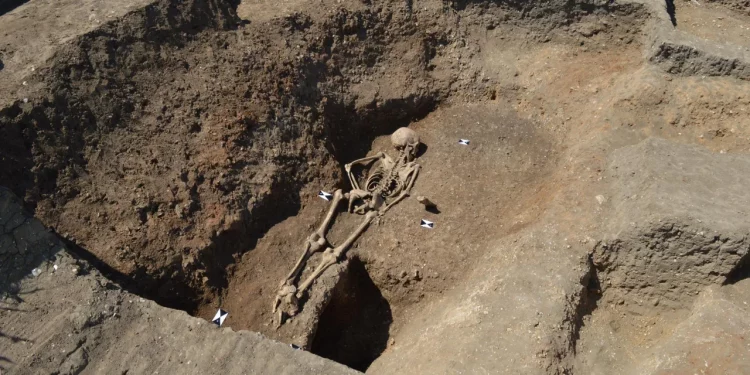In a recent revelation, a startling discovery has emerged from the excavation of an Early Medieval settlement near Conington, a quiet village nestled in southeastern England’s Cambridgeshire county. Archaeologists have uncovered the remains of a young girl, estimated to be 15 years old, buried in an unsettling and unusual manner.
The finding has led experts to speculate that the burial was intentionally performed to ensure the deceased could not “return” from the grave, shedding light on the intricate social dynamics of the time.
The excavation, carried out between 2016 and 2018, has captured the attention of researchers. The Museum of London Archaeology (MOLA) took on the task of examining the girl’s remains, and their findings have raised intriguing questions about Early Medieval burial practices.
Unlike the more common practice of arranging the deceased in a face-up position, this girl was found buried face down. According to MOLA, such a burial orientation was often reserved for individuals considered outsiders in society – those who deviated from norms, belonged to a lower social stratum, or had suffered untimely or violent deaths.
MOLA’s osteologists, experts in bone analysis, uncovered clues suggesting the girl’s humble social status. Absence of signs pointing to a prolonged, severe illness indicated that her death might have been sudden.
Childhood malnutrition was evident in her skeletal remains, along with signs of spinal joint disease, possibly exacerbated by her early exposure to laborious work.
“This burial provides an interesting, albeit tragic, opportunity to view the realities of life, and death, for those seen as outsiders in the past,” remarked Don Walker, MOLA’s senior human osteologist, CNN reports.
The placement of the girl’s ankles, indicating possible restraint, suggests that her community took special precautions to prevent her posthumous return, according to the report.
Adding to the intrigue, the burial site’s location carries significance. The young girl was interred in a pit that had once held a substantial wooden post marking the entrance gate of an enclosure.
This resonates with a similar case from the late 8th to 9th century, around 30 miles away, where a woman was buried face down, devoid of her arms, head, neck, and part of her spine – a possible sign of execution. Interestingly, the use of borders and boundaries for distinctive or unconventional burials seemed to be a trend during that era.
Radiocarbon dating places the girl’s death between 680 AD and 880 AD, and concurrent archaeological work indicates that the settlement’s activity tapered off during the 8th and 9th centuries.
This discovery not only offers a glimpse into an enigmatic past but also reminds us of the complexity of societies and their attitudes towards those who stood apart from the norm. The revelation invites further exploration into the customs and beliefs that shaped our historical landscape.












